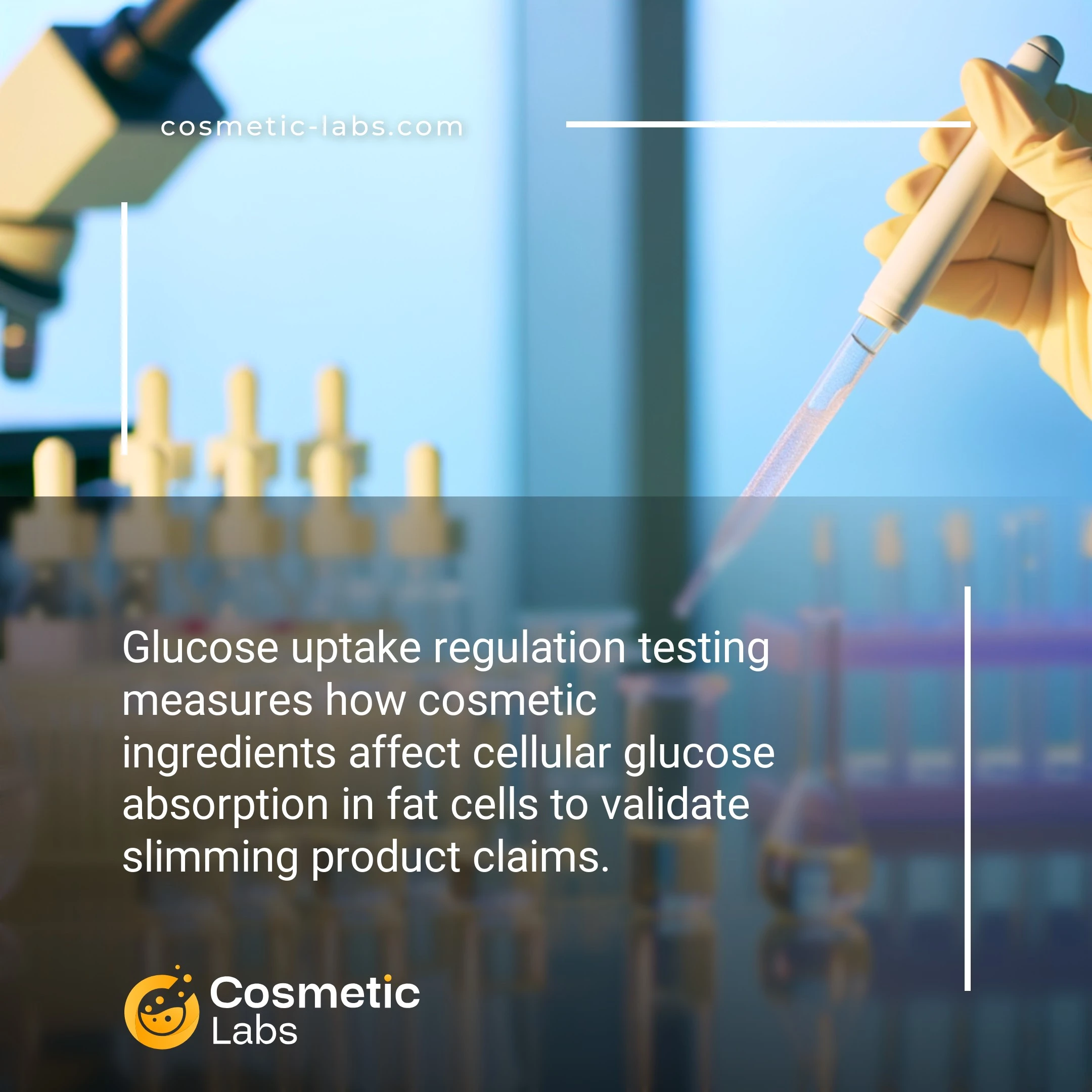Glucose Uptake Testing for Slimming Product Efficacy

What is Glucose uptake regulation?
Glucose uptake regulation testing for slimming measures how cosmetic ingredients influence cellular glucose metabolism in adipocytes to validate fat-burning claims. Our partner labs use in vitro adipocyte models to assess whether active compounds enhance glucose consumption, reduce lipid accumulation, or trigger lipolysis pathways. This preclinical testing provides the scientific data you need to substantiate slimming product efficacy before market launch.
Why do you need this service?
Cosmetic labs use glucose uptake assays to validate slimming ingredient claims by measuring how active compounds affect cellular sugar metabolism in fat cells. Brand owners rely on these tests to demonstrate their formulations boost metabolic activity and support regulatory-compliant marketing claims for body contouring products, serums, and topical treatments targeting localized fat reduction.
Who provides Glucose uptake regulation services?
All cosmetic labs providing Glucose uptake regulation services
There is no company providing these services at the moment.
Glucose Uptake Regulation Testing for Slimming Products
Glucose uptake regulation testing measures how cosmetic ingredients influence cellular glucose metabolism in adipocytes, providing concrete data on slimming product efficacy. This specialized testing helps brands validate claims about fat reduction and metabolic enhancement in their anti-cellulite and body contouring formulations.
Cellular Glucose Metabolism Analysis
Labs use adipocyte cell cultures to test how active ingredients affect glucose transport and utilization. The process involves exposing fat cells to test compounds and measuring glucose uptake rates using fluorescent glucose analogs or radioactive tracers.
Key testing parameters include:
- Glucose transporter (GLUT4) expression levels
- Insulin sensitivity measurements
- Metabolic rate changes in treated cells
- Lipogenesis inhibition assessment
Results show whether ingredients can reduce fat storage by limiting glucose conversion to lipids.
Regulatory Compliance and Claims Support
Testing protocols follow established guidelines for cosmetic efficacy studies, generating data that supports marketing claims about metabolic benefits. Labs provide detailed reports showing percentage changes in glucose uptake and statistical significance.
Documentation includes:
- Dose-response curves for active ingredients
- Comparative analysis against control groups
- Time-course studies showing onset of effects
- Cytotoxicity assessments for safety validation
This testing proves particularly valuable for brands developing products with caffeine, forskolin, or plant extracts claiming metabolic enhancement. Connect with specialized labs on our platform to discuss your glucose regulation testing requirements.
Practical Applications of Glucose Uptake Regulation Testing for Slimming Products
Cosmetic labs use glucose uptake regulation testing for slimming formulations to validate metabolic enhancement claims and demonstrate ingredient efficacy in adipocyte models.
Anti-Cellulite Cream Development
Product developers test botanical extracts and peptide complexes using glucose uptake assays to verify their metabolic activation properties. Labs measure glucose consumption rates in 3T3-L1 adipocytes after 24-48 hour treatment periods with test formulations.
This approach helps brands substantiate claims about enhanced cellular metabolism and fat-burning activity. Testing protocols typically involve dose-response curves from 0.1% to 2% active ingredient concentrations, providing clear efficacy thresholds for formulation optimization.
Body Contouring Serum Validation
Cosmetic manufacturers utilize glucose uptake studies to evaluate lipolytic ingredients like caffeine, carnitine, and forskolin derivatives. Labs track metabolic markers including glucose transporter expression and insulin sensitivity changes in treated cell cultures.
Results from these studies support product positioning and regulatory documentation. Brands receive detailed reports showing percentage improvements in glucose metabolism compared to untreated controls, typically ranging from 15-40% enhancement depending on ingredient potency.
| Test Parameter | Measurement Method | Typical Results Range | Application |
|---|---|---|---|
| Glucose Consumption Rate | Colorimetric assay | 10-50% increase | Metabolic activation claims |
| GLUT4 Expression | Western blot analysis | 1.2-3.0 fold change | Cellular uptake enhancement |
| Insulin Sensitivity | Glucose uptake stimulation | 20-60% improvement | Fat metabolism support |
| Cell Viability | MTT assay | >85% at test concentrations | Safety validation |
Connect with specialized cosmetic labs on our platform to access glucose uptake regulation testing services for your slimming product development needs.
